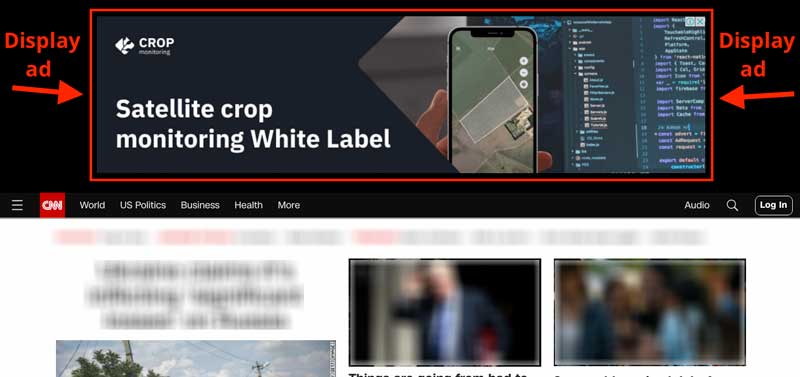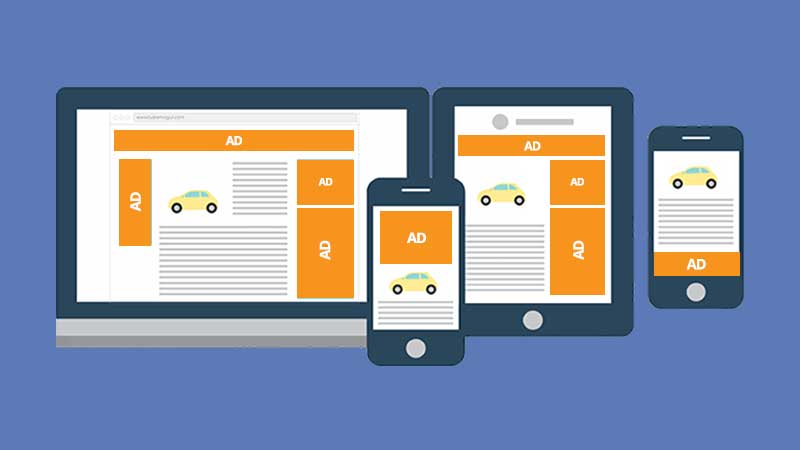In this article, you’ll learn what Google Ads display ads are, their types, as well as tips and essential info for running display campaigns.
Display ads are visual ads (usually with images, that’s why they are also called “graphic ads”) that are shown across the Display Network (officially the “Google Display Network” or simply “GDN”).

The Display Network helps your business reach people as they browse millions of websites (which are all part of it), apps, and other Google properties (like Gmail and YouTube).
Display campaigns are one of the campaign types available in Google Ads (among the others: search, video, app, Shopping, etc.). When you create a new campaign, you can always choose display.
Advantages of display ads
Optimized targeting
Find the best audience segments that include potential customers who are most likely to meet your conversion goals. Optimized targeting goes beyond handpicked audience segments and looks for other segments you may not have taken advantage of yet.
Create campaigns according to your goals
Increase sales, leads, and traffic to your website or build brand awareness (by showing your brand name) and consideration for your business, product, or service.
Designed to make the advertiser’s job easier
Display campaigns use machine learning in targeting, bidding and ad formats to reach new or existing audiences. This can help your campaign get better results.
Reach users in multiple places
Display campaigns can reach people around the world on 35 million websites and apps, as well as on Google properties (YouTube and Gmail). This allows you to expand your reach beyond Google search.
You can use smart bidding
Smart bidding uses machine learning to optimize for conversions or conversion value. It can help you save time and improve performance, if used wisely.
Disadvantages of display ads
They reach users when they are in another cycle
For example, you go to your favorite newspaper’s website to read the news, and as soon as the home page loads you see a display ad. At that moment, you are not actively looking for the ad’s product or service because you are there just reading your news.
This means display campaigns get clicks from users who are, in general, farther from making a final purchase decision.
That’s why in marketing language we say display ads are a more “top of funnel” type of media (referring to the sales funnel, where the top of the funnel is the stage where consumers are still distant from choosing to buy a product or service).
However, this can also be an advantage, as I explain below.
Results often require more investment and more time
It is very unlikely that you will get good results with display ads if you run them for short periods of time. The whole point of this type of media is simply “to appear” as many times as you can.
That’s why display ads are good for leveraging brand awareness: because they can put your brand name (along with your product or service) in front of a large audience.
While search ads reach people when they are looking for specific products or services, the Display Network captures consumers’ attention earlier in the buying cycle (before they are actively looking for what they want), as I explained above.
This means your display ads can reach people before they start looking for what you offer, which can be important to your overall marketing strategy.
But it takes time until your target audience has seen your brand name many, many times – enough to memorize it. And “time” here means, in most cases, months and years.
Thus, it would be useless to run a display campaign for two or three months for branding purposes (unless your target audience is concentrated in a small town and you have a high budget to show ads all the time, or anything similar).
I repeatedly tell my clients the same thing: in general, display ads are a luxury that only mid-sized and large companies can afford. Consistency is usually an issue here, and should always be taken into account: starting a display campaign and stopping after a few months is almost the same as wasting money, in most cases.
Lower conversion rates, in general
With the exception of display remarketing campaigns, conversion rates (mostly purchase conversions) for broad display campaigns are often significantly lower than conversion rates for search campaigns.
Display campaigns must be very well configured
Poorly configured display campaigns with broad location targeting (e.g.: including states or countries with large populations) can spend your budget too quickly and uncontrollably, which can result in poor, irrelevant traffic. So it is a type of campaign that requires very frequent monitoring (I’d recommend two or three times a day, at least in the first days).
Display ad types
Responsive Display Ads
These ads automatically adjust their size, appearance, and format to fit any available space and improve performance. You upload your assets (images, logos, videos, etc.) and write the titles and descriptions. Google Ads will make the optimal combination and size of these assets appear as ads on many websites, smartphone apps, YouTube, and Gmail.
You can also use the Google Ads image library for free, it has thousands of images that you can use in your ads.
Both beginners and more advanced advertisers can greatly benefit from responsive display ads because they appear as “native” ads, meaning they blend into the same font and style of the site they appear on.

Uploaded image ads (created by uploading images or HTML5)
You can also create your own ads and upload them to your Google Ads account. Simply create or edit your assets (photos, images, illustrations, etc.) in different sizes (so your ads can fit any space) or use HTML5.
Tips for getting good results with display ads
The Google Display Network can help your business find the right audience by using its targeting options, which allow you to strategically show your message to potential customers in the right place at the right time.
Below are some examples of how you can better target your display ads.
Find new customers or keep your existing ones by using audience segments
Similar segments and in-market segments help you find new potential customers by selecting people who are interested in your products. You can also use segments created from your own data to reach people who have already visited your site (so they can come back).
To know more about in-market segments, visit this page and scroll down to the paragraph that says “Different audience targeting options”.
Try to increase conversions or improve costs by using automation
Automated targeting can increase conversions by finding high-performing audience segments based on your existing audiences and landing page.
By automatically optimizing delivery over time, Google Ads can learn which audience segments work best for you.
Automated bidding automatically adjusts your bids to help you reach your optimal ROI (Return On Investment).
Smart Display campaigns try to combine the best of automated targeting, bidding, and creatives to improve your conversions.
But do keep in mind that you should use automation very carefully, monitoring your campaign and measuring the results often enough to see if it’s really worth it. You should always set maximum bid limits, if you can.
In your reports, pay close attention to placements
Placements are the websites and apps where your display ads are being shown. You should monitor the metrics of each placement very closely and remove placements with poor conversion rates or high cost per conversion on a daily basis.
Important: optimize your display campaign on a frequent basis
Once you start running your display ads, you’ll likely receive notifications based on the settings you’ve chosen.
These notifications can alert you to issues that could result in poor performance or could even prevent your campaign from running. So pay attention to these system alerts.
Aside from these notifications, you should always monitor your display campaigns manually as often as you can.
The navigation menu used when creating display campaigns (which appears as you build your campaign) provides a very comprehensive view of the creation progress and will always show notifications that you need to address.
Just go through the menu steps to review and troubleshoot any problems you have with your targeting, bids, budget, and other campaign settings.
Tip: always plan ahead
When creating a new display ad campaign (or when making changes to an existing campaign), keep in mind that Display Network changes can take 12-24 hours to take effect, which means they may not appear immediately. Therefore, it is best to create your ads days before the date you want to start running them.
Also, keep in mind that when you make multiple changes within a 24-hour period, they may be applied out of the chronological order in which they were made.
